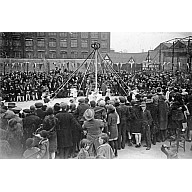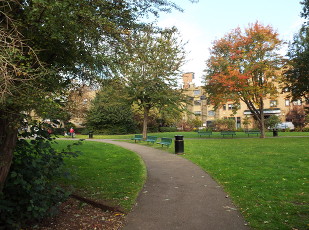





Exploring Southwark and discovering its history



Half of the workhouse site was owned by Bermondsey Council, the other half by a body of charity trustees, who were happy to sell their share to the Council for the price of £8,000 and on condition it was used as an open space. Bermondsey Council received costings to lay out the space as a public facility in the sum of £3,000 to £4,000, making a total of about £12,000 which needed to be spent on the new park. Bermondsey was a very poor borough and this was a large sum of money to find, despite contributions offered from the Metropolitan Public Gardens Association, the National Playing Fields Fund Committee and by the Carnegie Trustees.
However, Bermondsey Council was the owner of an open space close by to London Bridge in Tooley Street where the present St Olaf House (part of the London Hospital) stands. On this site the church of St Olave had been built in Norman times, named after King Olave of Norway, who had helped King Ethelred the Unready in repelling the Vikings. It was said that when the Vikings occupied London Bridge, he anchored his long ships to the bridge and pulled the supports down. Formerly a pagan, King Olave converted to Christianity and attempted to convert Norway to Christianity for which he was canonised.
By 1918, the area covered by the parish of St Olave was mainly commercial and included mainly wharfs, warehouses and associated businesses. The population had declined and the congregation had dwindled to just 13 people who were all resident caretakers of warehouses. The Ecclesiastical Commissioners applied to Parliament to close and demolish the church, and to sell the land. The Bill was controversial, with many feeling that the site and church should remain for its historical value and as a remembrance for St Olave as part of London’s heritage. The final Act allowed for 50% of the land to be sold to Hay’s Wharf and the remaining land passed to the Borough of Bermondsey to establish and maintain a public space named St Olave’s Garden. The demolition of the main church was allowed but the church tower was to remain, again maintained by Bermondsey Council.
Bermondsey Council were unable to take possession of the site until 1926 by which time the church tower had become dangerous, partly due to the demolition of the main church, and it was estimated the Council needed to spend £3,000 to £4,000 to make the tower safe. The remaining churchyard was a narrow tunnel like space, a “sunless, airless tunnel, and a very draughty tunnel”, surrounded by tall warehouses, and suffered the constant noise and fumes of heavy traffic transporting goods from the warehouses. As the resident population for the immediate area had dwindled which had led to the closing of the church, it meant there were very few local people who used the open space. Less than half a mile away, in the overcrowded area of Tanner Street, there was a desperate need for such an open space. Hay’s Wharf were extremely keen to purchase the former St Olave’s site and it seemed beneficial to all parties that the site be sold and the proceeds used by Bermondsey Council to purchase the charity trust’s share of the former workhouse site and to lay out the much larger site as a recreation ground. Bermondsey Council sought by Act of Parliament, proposed by MP for Bermondsey West, Dr Alfred Salter, to be relieved of their duty of trust in maintaining the churchyard and tower and be allowed to sell the site.
But there was opposition to the Bill, led by public school educated Sir Robert Hamilton, MP for Orkney and Shetland. Echoing the 1918 Act, the opposition centred around the need for a public space to remember St Olave and the need to preserve the church tower as having historical and architectural merit. This latter argument was quickly refuted by Dr Salter who quoted no less an authority than Lord Curzon. He went on to say:
“We shall acquire, for the money obtained by the sale of this space, an open space one acre in extent situated 450–480 yards away, in the middle of a residential district, surrounded by a densely crowded and overcrowded population. There are any number of young people who have no playing place whatever.
…
“We propose to utilise the ground [workhouse site] exclusively as a recreation ground for children and adolescents. We have a large child-population, which is densely overcrowded, and most of the houses in that vicinity have no gardens, many of them even not having backyards.
…
“We propose to allocate its use in the evenings and on Saturdays between the various clubs, such as the Boy Scouts, the Toc H, the Cambridge Mission, and other similar philanthropic bodies, which are doing magnificent work in that locality among the adolescents. During the daytime, we propose that it shall be used by scholars from the adjacent London County Council schools. We suggest that there can be no question from the point of view of the life and health of the coming generation as to the relative values and importance of these two sites.”
Dr Salter was supported by the Minister of Transport who endorsed the proposed building by Hay’s Wharf on the former church site as the designs included for the entire ground floor to be given over to car parking, much needed in an area of very congested roads. He went on to give his own personal views beyond those of transport matters:
“I would say that in a matter where such a doubt arises, the House of Commons will surely always give the preference to human beings over dead associations. We must consider the younger generation who are coming on, and see whether what is proposed will give them an opportunity for healthy recreation and games and a wider outlook. Let us not allow old associations ... to cloud our minds to the realities of the situation. I think the Bermondsey Borough Council are doing what is sound and right by their own inhabitants, and what is right as regards London as a whole.”
The Bermondsey Borough Council (St Olave’s Garden) Bill became law with 149 MPs voting for and 87 MPs voting against. The full transcript of the debate can be found here.
Tanner Street Park
Tanner Street Park is a small park on the corner of Tanner Street and Bermondsey Street. It was opened in 1929 and built on the site of the former Bermondsey workhouse. It seems an easy enough task, to demolish a workhouse and create a park, or a recreation ground, on the site, but the matter was fraught with financial and political implications, and required an Act of Parliament for it to come into being.

The Tanner Street Recreation Ground opened in May 1929 and Dr Salter planted a tree to mark the occasion. A new shelter had been built and the top of the much discussed St Olave’s church tower was installed in the recreation ground and converted into a water fountain. The size of the park was increased considerably when the adjoining warren-like Kinross Street and the buildings fronting onto Bermondsey Street were demolished in the early 1960s.
Today (June 2015) the church tower is in a very sorry state and the shelter is partially boarded up, though there is talk of it being taken over and becoming a café. A part of the park was refurbished in 2003 but there was insufficient money to refurbish the whole park. Funds have now become available through an S106 agreement and Southwark Council is currently consulting regarding further refurbishment.
Web discoveries
- UK Casino Not On Gamstop
- UK Casino Not On Gamstop
- Non Gamstop Casino
- Casinos Not On Gamstop
- Non Gamstop Casinos
- Non Gamstop Casinos
- Non Gamstop Casino
- Casino Sites Not On Gamstop
- Slots Not On Gamstop
- Casinos Not On Gamstop
- UK Betting Sites Not On Gamstop
- UK Casino Not On Gamstop
- Best Non Gamstop Casinos
- Betting Sites
- Non Gamstop Casino Sites UK
- Best Non Gamstop Casinos
- Non Gamstop Casino
- Casinos Not On Gamstop
- Non Gamstop Casino Sites UK